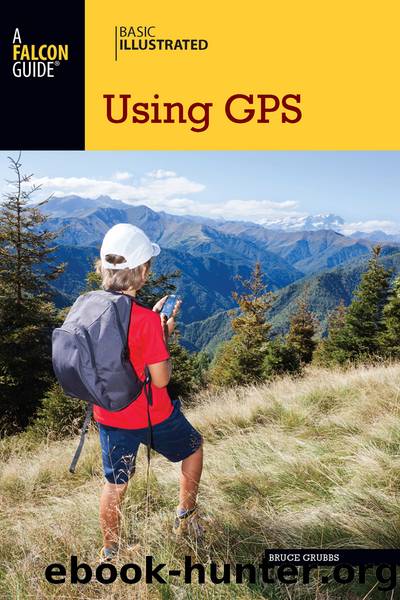Basic Illustrated Using GPS by Bruce Grubbs

Author:Bruce Grubbs
Language: eng
Format: epub
ISBN: 9781493016907
Publisher: Falcon Guides
Most GPS receivers have a map screen that shows your position in relation to waypoints. Your course (also called the desired track, or DTK) is shown as a straight line from waypoint to waypoint along your current leg. Your TMG is also shown as you progress. Often, bearing and distance to the next waypoint are shown, along with heading (your current direction of travel) and speed. (Again, these data fields can be added or customized on most receivers.) The map screen gives you an easy-to-understand graphic of your navigation. On most receivers a basemap shows major roads and cities. Mapping GPS receivers can display detailed maps, including topographic maps and land ownership maps. Units that allow you to load custom maps can use free maps from sources such as gpsfiledepot.com, including detailed topo maps.
Although detailed maps are very useful to have on your GPS receiver, they are no substitute for paper maps. The tiny screen on the GPS receiver canât give you the big picture of your surroundings, and the GPS receiver can fail, leaving you without a map.
As you travel, the GPS constantly updates the navigation information. The GPS receiver will display a warning on the screen when you are approaching a waypoint. Most receivers can be set to give an audible warning as well.
At low speeds (under 5 to 10 miles per hour), GPS receivers may not compute speed consistently due to the accuracy limits of the GPS system. If the displayed speed and ETA fluctuate as you move, you have to either average them in your head or ignore them. Some receivers have an averaging function to smooth out the ETA calculation, making them more useful at low speeds. Still, the best way to navigate at walking speeds is to use the receiver while stopped. Get a position fix, save it as a waypoint if necessary, note the bearing and distance to the next waypoint, and then shut off the receiver. Use your compass, the sun, or the lay of the land to determine your direction, and then use landmarks or the compass to maintain that direction as you travel.
Download
This site does not store any files on its server. We only index and link to content provided by other sites. Please contact the content providers to delete copyright contents if any and email us, we'll remove relevant links or contents immediately.
The Total Outdoorsman Skill & Tools by T. Edward Nickens(263)
Camping Guide: Skills You Need (Field & Stream) by T. Edward Nickens(260)
How to Stay Alive: The Ultimate Survival Guide for Any Situation - PDFDrive.com by Bear Grylls(259)
Survival Skills: Survival Guide by Seth Walker(251)
Muir Trail Magic by Arnold Marsden(251)
Complete Works of Oppian by Oppian of Cilicia(244)
How to Hunt Deer Up Close: With Bows, Rifles, Muzzleloaders and Crossbows by John E. Phillips(235)
Outdoor Life: The Ultimate Shooting Skills Manual by John B. Snow(228)
You vs the World by Bear Grylls(227)
Grand Canyon Christmas by Arnold Marsden(215)
Backpacker magazine's Hiking and Backpacking with Kids by Molly Absolon(212)
The Best American Science and Nature Writing 2023 by Carl Zimmer(198)
Let Me Be The One: MM Best friends to Lovers by Z.S. STORM(195)
Survivalist Magazine Special Edition Editor's Choice by Lisa Bedford & Mat Stein & Robert Scott Bell & Sergei Boutenko & Owen Geiger & Dr. Joseph Alton (aka Dr. Bones) & Julia Soliday & Ed Corcoran & Doug Bell & George Shepherd(187)
Body Language at Work by Editors of Adams Media(176)
The Scouting Guide to Survival: An Official Boy Scouts of America Handbook: More Than 200 Essential Skills for Staying Warm, Building a Shelter, and Signaling for Help by The Boy Scouts Of America & J. Wayne Fears(176)
Hook, Line & Sinister by T. Jefferson Parker(163)
Whats in Your Bug Out Bag by Unknown(163)
Woman, Captain, Rebel by Margaret Willson(151)
